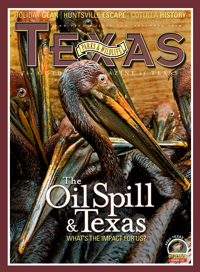
Life Flight for Pelicans
Nearly 200 oiled birds have been released on the Texas coast.
By Rusty Middleton
“That was one of my 10 best days at work,” says Texas Parks and Wildlife Department biologist Andy Tirpak as he recalled the July 28 release of 16 brown pelicans at Goose Island State Park near Rockport.
That day, about a dozen media outlets, including four television news crews from as far away as Europe along with numerous print journalists, and about 70 members of the general public watched solemnly as Tirpak and other wildlife personnel unloaded pet kennels in shallow water on the beach. They opened the cages, and 16 survivors of the BP Deepwater Horizon oil spill disaster cautiously emerged into the waters of St. Charles Bay.
Slowly, they began to move offshore about 50 yards, and finally a few flew off. Suddenly, the mood changed, people began to applaud, and a cheer went up. One of the local print reporters was moved to tears.
“It was kind of an emotional deal for most people there,” says state park ranger Bill Wilson. “I had goosebumps. I think everybody felt like we were witnessing a part of something much bigger.”
If the observers were elated, the pelicans must have been even happier. They had endured much to make it to the safety of this beach in Texas. These lucky ones were just a handful of the thousands of oiled birds recovered from Gulf waters and coastal marshes near the disaster.
As of Sept. 5, 7,726 oiled birds had been collected, but only 2,053 were found alive. Of those, 1,175 were released back into the wild in Louisiana, Florida and Texas. Some of the younger birds were being held back until water conditions improved.
When found, most of the birds had been so covered in oil they couldn’t fly. They were hurried to a bird recovery facility in southern Louisiana, where they were first allowed to rest and calm down. Then came thorough scrubbing with detergent and water hoses. For some larger birds, such as brown pelicans, cleaning can take as long as 45 minutes and require 300 gallons of water. In some cases, birds in bad condition were forcibly rehydrated.
When finally cleaned, they were all confined for feeding, observation and recovery, but their ordeal was still not over. The birds that made it through this phase were loaded into large pet carriers, trucked to a New Orleans-area airport and then flown for hours across the Gulf in a Coast Guard cargo plane. Finally, they were trucked in a convoy to the Goose Island State Park beach, where camera crews, reporters and citizens awaited them. Even the Coast Guard pilots came along to help with the release.
Before the release, all the rehabilitated birds were banded. They got both a standard U.S. Fish and Wildlife Service band and a colored band that can indicate from a distance that they are birds rescued from the oil spill.
“There is some concern the older birds may find their way back to their former homes and possibly be oiled again,” says Tirpak. “We really don’t know for sure just what they will do.”
A total of 194 birds, mostly brown pelicans but also a few terns and a gannet, have been released on the Texas coast at both Aransas National Wildlife Refuge and Goose Island State Park.
|

